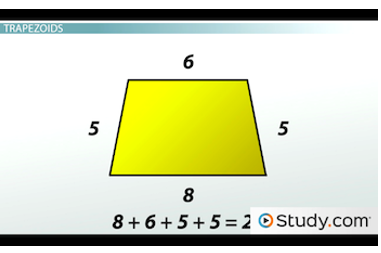
The area of a parallelogram is base times height.
The area of a parallelogram is the base times the height. So, in this example, where the base is 7 inches and the height is - whoa, wait, 4 is not the height! Remember, the height is the distance from the base to the top, so while that side is 4 inches, the height is actually 3 inches:

The area of this parallelogram is 21 square inches.
So, the area is 7 times 3, or 21 square inches.
This is the same area formula as with squares and rectangles. And, if you remember, squares and rectangles also have sets of parallel sides, so they're both parallelograms!
Trapezoids
But, what if only one set of sides of a quadrilateral is parallel? Then, it can't be a parallelogram. But, it is a trapezoid. A trapezoid is a four-sided shape with at least one set of parallel sides. It can have two and be a parallelogram. But, if two sides aren't parallel, then it's just the lowly trapezoid.
That's a weird name, and it can be kind of a weird shape. You know what it reminds me of? A table. And, guess what? That's where the name comes from! Like a table, two sides, or the tabletop and the base, or the floor, need to be parallel. If not, your poor meatball may roll off the table and right out the door.
So, in a trapezoid, the parallel sides are called the bases. And, just like with a table, the other sides are called legs.
The perimeter is the same as with parallelograms. The perimeter of this trapezoid?

The perimeter of this trapezoid is 24 inches.
Let's see. The bases are 8 inches and 6 inches. The legs are 5 inches each. 8 + 6 + 5 + 5 = 24 inches.
Area is a little more complicated. You can't just multiply base times height, because the bases are different. So, the area of a trapezoid is the average of the bases times the height. Or, (a + b) / 2 * h.
Let's find the area of this one:

The area of this trapezoid is 28 square inches.
The bases are 8 inches and 6 inches. What's the height? The legs are each 5 inches. Remember, the height is the distance from one base to the other. The height of this trapezoid is 4 inches. Let's plug those numbers into our formula: 8 + 6 = 14. 14 / 2 = 7. 7 * 4 = 28. That's 28 square inches.
Polygons
We've been talking about four-sided objects, but what's the term that also includes shapes with different numbers of sides?
Whoa. No. That's polygamy, or marrying multiple people. I meant polygons. Totally different. But, notice that they both begin with poly-. The prefix poly- comes from the Greek word for many. And, -gonmeans angles. So, a polygon is a closed, two-dimensional shape with many sides and angles. Polygons are polygamous in that they are shapes that join multiple sides and angles.
There's really no more to them. They can have three sides or eight, like an octagon, or a million, like the megagon. They don't need to have parallel lines or right angles. If you think about that, it means that a triangle is a polygon. So are squares, rectangles and, yes, quadrilaterals, parallelograms and trapezoids. They all are closed shapes with many sides, so they're all polygons!
The perimeter of a polygon is still just the sum of the sides. It's 3 for the top shape below, 5 for the one on the left, and 8 for the shape on the right.

Examples of polygons
Since polygons can get awfully complicated, determining their areas is more advanced math than we're going to get into here. But, no matter how big or small that stop sign is, you still need to obey it!
Lesson Summary
In summary, a quadrilateral is any four-sided shape.
A parallelogram is a four-sided shape with opposite sides that are both parallel and equal in length. The area of a parallelogram is the base times the height.
A trapezoid is a four-sided shape with at least one set of parallel sides. The area of a trapezoid is the average of the bases times the height.
Finally, a polygon is a closed, two-dimensional shape with many sides. Everything from a triangle to an octagon to a megagon is a type of polygon.
For all of these shapes, the perimeter is the sum of the sides.